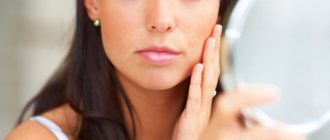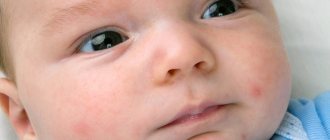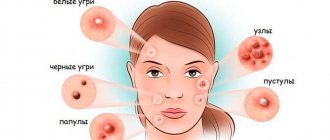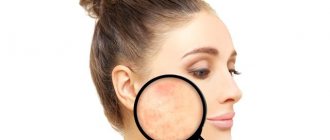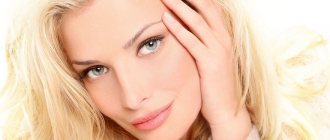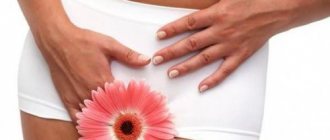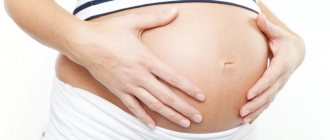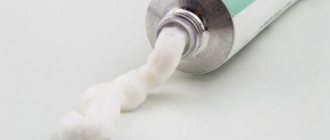This article uses excerpts from the chapter of the same name in the Face Anatomy atlas. It is of particular importance for specialists involved in the correction of age-related changes and contouring using fillers. The title “Dangerous triangle of the face” was not chosen by chance; it is in this zone that there are prerequisites of an anatomical and functional nature that can interfere with medical manipulation and cause side effects, including severe ones. Let's look at the topography of this triangle and the reasons for its danger.
Introduction
So, a dangerous triangle of the face. We can describe this zone in this way: the apex of the triangle is located in the glabella area, its legs enclose the nasolabial folds and reach the base, which is located under the lower lip [Fig. 1].
Rice. 1. Dangerous triangle of the face.
The area within this zone is often corrected with filler: just think about glabellar lines, nasal hump correction, nasolabial folds and lip remodeling. The anatomical feature, or originality of this zone, which makes it so “insidious”, lies in its blood supply and especially in the topography of the arteries.
Why you shouldn’t squeeze pimples in the “triangle of death”
© Getty Images
This area is connected by blood vessels in the skull area, where infections can quickly spread and become more severe.
.
If the skin inside the triangle is damaged by a cut or squeezed pimple, bacteria enter the body.
- One of the common infections in this area is staphylococcal infection
. These bacteria quickly enter the body and cause infection, and due to their proximity to critical areas of your brain, the infection can quickly lead to serious complications.
- Just below the nose and mouth are four major cranial nerves that control functions in and around the face. Depending on which nerve is infected, there may be paralysis of several parts of the face
including the eyelids and mouth, motor function may be impaired and vision loss may occur.
- Infection may also result in cavernous sinus thrombosis
. This disorder can lead to blood clots, which increase the risk of stroke and death.
The skin on the face, especially in the “triangle of death”, is the first line of defense against bacterial invasion. If you damage this barrier, it can have dangerous consequences.
Triangle and arteries
One of the main arteries in this area is the facial artery, a branch of the external carotid artery. The facial artery, immediately after its origin, goes upward and passes to the face in front of the masticatory muscle, where its pulsation can be determined by palpation. Next, it is directed medially and towards the lips, giving off branches - the superior and inferior labial arteries, then passes under the muscle that lifts the upper lip, and reaches the wing of the nose, where its course becomes superficial and ends with two terminal branches - the arteries of the wing of the nose and the angular . Up to this point, everything is clear and clear, but in reality this is not always the case [Fig. 2].
Rice. 2. Facial artery - angular artery.
I will explain more clearly: there are many works with cadavers that emphasize the fact of the existence of frequently encountered anatomical variations and the place of origin of the facial artery, the course of this vessel and its branches. Often such variations are more the norm than the exception. Therefore, it can be argued that even with in-depth knowledge of anatomy, there is a possibility of complications due to the abnormal arrangement of blood vessels. Therefore, it is necessary to use techniques that help to avoid possible side effects as much as possible.
Where is the triangle of death located?
The area on the face connecting the nose and the corners of the mouth is considered particularly vulnerable, as it is closely connected to our brain.
© Alliance Images
The best way to see the triangle is to form it with your fingers by connecting the tips of your thumbs and index fingers.
The tip of the triangle is the bridge of your nose, and its base starts at the corners of your mouth and extends to the contour of your upper lip.
Why is this area called the “triangle of death”? The fact is that the cavernous sinus
- a large vein that drains blood from the brain, creating a connection between the external and internal environment.
Possible side effects
Basically, complications arise not so much due to rupture of a venous vessel, but due to interruption of arterial blood flow due to compression or when the drug is administered into the lumen of the vessel with subsequent embolization of the terminal branches with small fragments [Fig. 3].
Rice. 3. Reasons for the development of skin necrosis. Intravasal injection (top), vessel compression (bottom).
What could happen next? Stopping arterial flow leads to necrosis and tissue death in the blood supply zone of a given vessel. Cases of necrosis of the skin of the wing and tip of the nose, lip tissue and glabella area have been described [Fig. 4–5].
Rice. 4. Necrosis of the tip or wing of the nose.
Rice. 5. Zones of necrosis.
An even more serious risk factor is associated with the fact that the facial artery represents the communication between the external and internal carotid arteries. Its terminal branch, the angular artery, anastomoses with the ophthalmic artery, a branch of the internal carotid artery. It is this connection between the vessels that can lead to embolization of the ophthalmic artery with small fragments of filler and further penetration into the central retinal artery with a possible decrease in vision up to blindness [Fig. 6–7].
Rice. 6. Iatrogenic retinal artery occlusion caused by the injection of fillers.
Rice. 7. Microembolism of the ophthalmic artery: etiopathogenesis.
Varieties
There are different types of acne on the nasolabial folds:
Treatment for acne depends on the type and cause of its appearance.
Comedones. These are small black dots. They appear due to increased activity of the sebaceous glands when the pores become clogged. Over time, sebum oxidizes and turns black. Comedones can be closed or open.- Papules. Small blackheads with a white head that cause pain when pressed.
- Pustules. Medium-sized purulent rashes. They manifest themselves as painful sensations, itching and redness. To remove them, pulling agents or mechanical cleaning are used. Traces may remain after the pustule.
- Cystic acne. This is a severe form of rash in the form of large cysts. The formations are dense, painful, and very itchy. After the rash disappears, scars remain.
- Lightning rash. The rash appears due to a sudden decrease in immunity. Such acne is accompanied by fever and weakness.
Therapeutic strategies to prevent and manage complications
It is obvious that it is necessary to use techniques that minimize the risk of developing these dangerous complications. The text of the atlas describes, area by area, all the precautions and manipulations that must be taken to reduce this risk: the use of a cannula, the depth of injection, the quantity and quality of filler injected, and so on. Pallor of the skin and patient complaints of sudden pain in the injection area are signs that blood flow has stopped in this area. We must be able to control this situation.
All measures are aimed at restoring blood flow: urgent dissolution of the filler (if hyaluronic acid was used), warm compresses, massage, etc. Then there are prescriptions that need to be followed at home: antibiotic therapy to prevent bacterial superinfection, antiplatelet agents, topical medications.
In the introduction to the atlas I placed the inscription
“Only non-practitioners do not make mistakes; only through practice does it become possible to reduce the risk of error.”
If all measures are carried out on time and correctly, the spread of the necrosis zone will be minimal, a large area of skin will be preserved and, therefore, the chance of restitutio ad integrum will be higher.
Squeezing out blackheads in other areas
You can squeeze out pimples on other parts of your face , such as your forehead or cheeks, but only in a dermatologist's office. The doctor himself will perform professional facial cleansing:
- mechanical;
- ultrasonic;
- chemical.
The doctor, based on the skin type and other characteristics of the body, will select the most effective method and carry out the manipulation in compliance with all sanitary standards. Only a professional can properly remove the pus so that it comes out completely and does not leak into the underlying tissues and bloodstream.
More and more Western dermatologists are abandoning the procedure of mechanical facial cleansing. It is believed that it is not only traumatic, but also ineffective. In addition, any manipulation that was performed incorrectly can lead to complications.
Possible complications
Before you start squeezing out pimples on your own, you should familiarize yourself with the list of complications that this is fraught with.
Independent actions to neutralize acne can lead to the following complications:
Hyperpigmentation. Due to damage to small capillaries and larger vessels, bluish spots appear.- Scars. Squeezing out purulent contents ruptures the subcutaneous epidermal layers. The wound heals and a scar forms.
- Infection. Under pressure, pus can seep into nearby pores. By squeezing one pimple, you can get an entire colony-settlement instead.
- Sepsis. After opening the pustules, the wound remains open. It can contain pathogenic bacteria. With the flow of blood and lymph, they begin their journey through the body, which can end in sepsis.
- Blood clot detachment. Microscopic particles of damaged tissue can get inside the capillary. There the clot will increase. In the event of an unfavorable combination of circumstances, such a blood clot can enter larger vessels and travel through the bloodstream to the brain or heart. So it turns out that squeezing a pimple can result in a heart attack or stroke.
If you can't, but really want to
There are few people so pedantic and careful who would go to the doctor to remove one pimple. Especially if the abscess was discovered on the eve of a birthday, wedding or other important event and you simply cannot get to the doctor.
In such an exceptional case, is it possible to squeeze them out? Acne is the only type of pimple that you can remove on your own. But subject to all precautions:
- Before starting the procedure, wash your hands thoroughly with soap;
- Then wash your face and steam the skin with a decoction of any medicinal herbs (St. John's wort, celandine, oak bark, string). If there are no herbs, you can simply sit, covering your head with a towel, over a bowl of boiling water.
- Wipe the area with the pimple with chlorhexidine;
- Wrap your index fingers in several layers of sterile bandage. You can use cotton pads;
- Using your index fingers, try to press on the root of the eel. This should be done carefully, without pressing the pimple inside;
- Squeeze out the pus until a drop of blood appears;
- Treat the wound with hydrogen peroxide;
- Apply a small piece of cotton wool moistened with salicylic acid to the wound for two to three minutes;
- Do not use decorative cosmetics for 48 hours after acne removal;
- A crust should form in place of the former pimple. You can’t rip it off; in a few days it will fall off on its own.
Traditional recipes for removing acne
You should squeeze out blackheads yourself only as a last resort. If the cause of their appearance is not identified and eliminated, they will appear again. Therefore, squeezing is not the most effective way to fight.
At home, you can use masks and scrubs. Scrubs are used only if there are no inflamed elements on the skin. A mixture of any anti-blackhead cleansing gel and fine salt and soda can effectively cleanse pores. Mix all ingredients by eye and treat problem areas twice a week.
A mask with egg white also effectively cleanses pores. Beat the egg whites with a mixer until foamy, then add a few drops of lemon juice. Apply to entire face for 15 minutes. A white clay mask with hydrogen peroxide gives good results. All you need to prepare it is mix the clay powder with peroxide until it reaches the consistency of sour cream. Apply to face and leave until completely dry. Then rinse with water and apply a pore-tightening cream.
The listed methods are completely unsuitable if there are red, purulent pimples on the face, especially boils. In order to safely get rid of such a pimple, it is better to purchase Vishnevsky or ichthyol ointment at the pharmacy. Apply the ointment directly to the inflammation, cover with a cotton pad and secure with a band-aid.
This compress can be left on all night. If you don’t need to go anywhere during the day, apply a compress for the day. Gradually the pus will come out completely without causing any harm.
How to warn?
First of all, to prevent the occurrence of rashes around the lips and nose, you should follow the rules of personal hygiene. To cleanse the skin you need to use special cosmetics or soap with tar. Do soft peeling with fruit acid scrubs 2 times a week. To avoid acne, it is very important to eat well. It is worth including more fresh vegetables and fruits, sea fish and nuts in your diet. They also recommend drinking at least 1.5 liters a day of pure water or freshly squeezed juice. You should avoid eating spicy, fatty and fried foods, sugar and strong coffee. You should not touch the skin of your face with your hands unnecessarily, as many germs accumulate on them, which can cause a rash. To maintain healthy skin, it is useful to walk longer in the fresh air and exercise.
Treatment options
Traditional
Pimples under the nose are treated with anti-inflammatory and disinfectants - iodine, salicylic acid or zinc ointment. The drugs are applied locally to the affected area of the skin. Pustules and cystic acne are more difficult to eliminate. For their treatment, complex treatment is used, which includes antiseptics, antibacterial drugs, retinoids, as well as stretching and healing medications. For severe acne, doctors prescribe oral antibiotic tablets in addition to external medications. Acne of hormonal origin is treated with hormonal drugs such as Yarina or Jess.
The table shows the most popular remedies for rashes in the nasolabial triangle:
| Types of medications | Titles |
| Antiseptic | "Chlorhexidine" |
| "Miramistin" | |
| Iodine | |
| Antibacterial | "Baneotsin" |
| Erythromycin ointment | |
| "Zinerit" | |
| Anti-inflammatory | Salicylic acid |
| Boric acid | |
| Tincture of calendula | |
| Hormonal | "Yarina" |
| "Janine" | |
| "Jazz" | |
| Retinoids | "Roaccutane" |
| "Differin" | |
| "Radevit" | |
| Pull-out | Ichthyol ointment |
| "Levomekol" | |
| Vishnevsky ointment | |
| For scars and spots | "Kontraktubex" |
| "Solcoseryl" | |
| "Actovegin" |
Folk remedies
Acne on the nasolabial folds can be effectively treated using traditional medicine. These are homemade ointments, mash, lotions, compresses, decoctions and tinctures of medicinal herbs. Medicines relieve the inflammatory process, disinfect the epidermal layer and dry out small pimples. Folk remedies have a minimum of side effects. The most effective medicinal plants against rashes: calendula, chamomile, sage and string.
You can use products made at home.
You can get rid of acne under your nose with aloe lotion. The solution relieves inflammation, itching, nourishes and moisturizes the dermis. To prepare, take freshly squeezed plant juice and dilute it in equal proportions with water. Wipe pre-cleansed facial skin with lotion 2 times a day. Masks made from potatoes, cucumbers, honey and lemon give good results against rashes. A mask made from cosmetic clay has proven itself best. The clay is diluted with water to a thick sour cream and smeared on the face. Keep the mixture until completely dry, and then wash off with warm water. After the procedure, lubricate the skin with moisturizing cream. Pimples in the nasolabial triangle area can be eliminated by cauterization with tea tree oil or salicylic acid.
Reasons for appearance
Acne in the area of the nasolabial triangle appears due to the influence of internal and external factors, which include:
- hormonal disorders;
- failure to comply with personal hygiene rules;
- poor nutrition;
- frequent stress and nervous tension;
- allergic reaction to cosmetics;
- taking hormonal medications;
- diseases of the gastrointestinal tract;
- infectious skin diseases.
Return to contents
